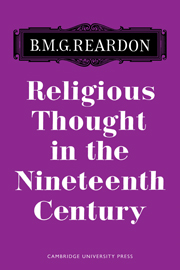Book contents
- Frontmatter
- Preface
- Contents
- Introduction
- PART I EUROPEAN
- PART II BRITISH AND AMERICAN
- 1 Coleridge
- 2 F. D. Maurice
- 3 Newman
- 4 Mansel
- 5 J. S.Mill
- 6 Benjamin Jowett and Essays and Reviews
- 7 Matthew Arnold
- 8 Scott Holland and Lux Mundi
- 9 The British Hegelians
- 10 Emerson
- 11 Josiah Royce
- 12 William James
- Index of Works Cited
- Frontmatter
- Preface
- Contents
- Introduction
- PART I EUROPEAN
- PART II BRITISH AND AMERICAN
- 1 Coleridge
- 2 F. D. Maurice
- 3 Newman
- 4 Mansel
- 5 J. S.Mill
- 6 Benjamin Jowett and Essays and Reviews
- 7 Matthew Arnold
- 8 Scott Holland and Lux Mundi
- 9 The British Hegelians
- 10 Emerson
- 11 Josiah Royce
- 12 William James
- Index of Works Cited
Summary
Best known and most widely read of American thinkers at the turn of the last century was unquestionably William James, elder brother of Henry James, the novelist. Born in New York in 1842, he attended a series of private schools both there and, later, in France, England and Switzerland. He returned to the U.S.A. at the age of 18 to study art under W. M. Hunt of Boston, but after a year he abandoned this for science and entered Harvard University, where his teachers included Charles W. Eliot and the naturalist, Louis Agassiz. In 1863 he began the study of medicine and two years later joined an expedition led by Agassiz to the Amazon. Recrossing the Atlantic, he settled for a time in Germany, to continue his medical training under, among others, Helmholtz. But his own ill–health—he was to suffer much from neurasthenia—prevented him from taking up medical practice. Moreover, his interest was already turning to psychology and philosophy. In 1872 he commenced his teaching career at Harvard, lecturing on physiology and anatomy, and in 1876 was appointed assistant professor of physiology. It was largely through his efforts that the first laboratory for psychological research in the U.S.A. was established. In 1878 he married. From 1880 to 1885 he was assistant professor of philosophy, and then, until 1889, full professor. In the latter year he changed to the chair of psychology, but resumed that of philosophy in 1897 and occupied it till his retirement in 1907. He died in 1910.
- Type
- Chapter
- Information
- Religious Thought in the Nineteenth Century , pp. 392 - 404Publisher: Cambridge University PressPrint publication year: 1966

